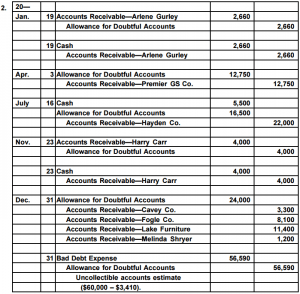It helps businesses identify overdue accounts and assess the effectiveness of their collections process. Furthermore, accounts receivable are current assets, meaning that the account balance is due from the debtor in one year or less. If a company has receivables, this means that it has made a sale on credit but has yet to collect the money from the purchaser. Accounts receivable (AR) is the balance of money due to a firm for goods or services delivered or used but not yet paid for by customers. Any amount of money owed by customers for purchases made on credit is AR.

Why is accounts receivable management so important for businesses?
For unpaid invoices, Versapay generates automated dunning letters—notifications—to expedite payment collection. A dunning letter is a collection notice that alerts a customer to overdue payments. Effective dispute management practices—a facet of AR management—strengthen customer relationships and enhance loyalty over time. Many organizations still rely on manual invoicing, phone follow-ups, https://www.online-accounting.net/ and archaic data systems. Meanwhile, companies that are digitizing and automating accounts receivable management tasks are leaving competitors in the dust as they leverage automation to boost cash flow and enable future growth. The Accounts Receivable process often involves a range of manual tasks, those manual actions both create costs and decrease collector effectiveness.
Corporate Finance Institute
The higher the ratio, the more efficient you are at collecting receivables. And while not a traditional metric, customer satisfaction is important financial statement cheat sheet in assessing the effectiveness of AR management. Such challenges can negatively impact your business with delays in payment collection.
Traditional vs. Modern Accounts Receivable

Receivables management begins before the sale is made when a number of factors must be considered. If you’re on the hunt for an accounts receivable automation solution, consider Centime. It’s a premier suite of cash management applications that help you achieve your cash flow goals.
Clear internal processes
Freelancers or sole proprietors may handle AR when first starting out, while larger companies are more likely to have a dedicated AR department. Everything you need to know about the accounts receivable process, including best practices and common challenges. AR management faces many challenges that can slow and undermine its effectiveness. Poor communications between the business and customers can impact the business’s ability to follow through on payments due. In this way, modern, digital accounting help businesses enhance and improve their management of accounts receivable. The processes and metrics mentioned above contribute to the overall management of accounts receivable.
What Are Accounts Receivable (AR)?
Schedule a demo today and discover how our autonomous solutions can boost your efficiency and financial success. In B2B transactions, particularly those involving deferred payments, maintaining high-quality standards is essential. Quality should encompass not only the products or services you provide but also the quality of customer interactions at every stage of engagement.

To prepare the aging schedule, a classifying of customer account balances is performed with age as the sorting attribute. Unlock the full potential of your AR management by implementing Key Performance Indicators (KPIs) to monitor and streamline AR-related tasks and issues. The following 3 core KPIs empower you to track the efficiency of your AR process, identify areas for improvement, and optimize your financial operations.
It not only establishes payment terms but also greatly influences the speed at which payments can be collected. By ensuring invoices are sent promptly, you set a positive foundation for the entire payment collection process, enabling your business to receive payments promptly. Regularly follow up on past due invoices and overdue payments, which involves tracking payment due dates and contacting clients to remind them of outstanding invoices. Try to set automatic reminders to streamline this process and minimize the chances of human error.
Provide contact information on customer-facing materials so customers know who to reach out to with questions. A common misconception is that the biggest accounts receivable challenges are related to late payments or high DSO. These https://www.personal-accounting.org/blog/ are actually consequences of having poor AR management processes in place. Accounts Payable (AP or A/R), sometimes called “payables,” is the amount of money a business owes goods or services it receives on credit from a vendor.
It acts as a connection between sales and revenue, ensuring that transactions are completed through timely payments. One of the primary goals of accounts receivable management is to ensure the timely collection of outstanding invoices. This ensures strong cash flow and can strengthen your customer relationships. Accounts receivable, abbreviated as AR or A/R,[1] are legally enforceable claims for payment held by a business for goods supplied or services rendered that customers have ordered but not paid for. The accounts receivable process involves customer onboarding, invoicing, collections, deductions, exception management, and finally, cash posting after the payment is collected.
- The higher the ratio, the more efficient you are at collecting receivables.
- The main objective of accounts receivable management is to ensure the timely collection of payments for goods or services provided to customers.
- You may only accept certain forms of payment or there may be too much administrative work involved.
- Some firms charge late fees after a specific due date, and include the terms of the fee on each invoice.
- We’ve also included a couple of solutions that nearly made our list and a few products you can skip.
However, this process can sometimes be challenging due to factors such as missing remittance advice or discrepancies between the provided payment information and open invoices. This process is essential for converting sales into actual revenue, which is vital for the financial health and growth of a business. Yet, managing it effectively can be a complex task fraught with challenges—from delayed payments to reconciliation errors. Can manually enter time in Essentials plan and higher; automatic time tracking costs extra. Stay in touch with clients through the FreshBooks mobile app and get notified when invoices have been viewed or become overdue.
Rick simplifies complex financial concepts into actionable plans, fostering collaboration between finance and other departments. With a proven track record, Rick is a leading writer who brings clarity and directness to finance and accounting, helping businesses confidently achieve their goals. Arguably the most important part of an AR process, ensuring customers have a full understanding of payment terms and policies, can prevent issues from arising when it comes to actually settling invoices. 💡 Implementing Accounts Receivable automation software can reduce your time spent on cash collection by 80%. Check out this customer success story to find out how we did this for Gymlib.
💡 AR automation helps collect 99% of payments within 60 days after invoice due dates. Save yourself time and add consistency to your process by automating account communications with your clients and reducing manual processes when possible. This ‘soft touch’ approach keeps communication open between you and your customer and ensures that they are aware of any upcoming payments. Remember that every touchpoint a customer has with your business (for instance, customer success) is an opportunity for you to proactively remind them. You may or may not be interested in making credit available to some clients.
The goal is to minimise the amount of receivables that are old, particularly those invoices that are over 60 days old. Liquidity is defined as the ability to generate sufficient current assets to pay current liabilities, such as accounts payable and payroll liabilities. If you can’t generate enough current assets, you may need to borrow money to fund your business operations and logistical costs. Accounts receivable is the amount of credit sales that are not collected in cash. When you sell on credit, you give the customer an invoice and don’t collect cash at the point of sale. Plus, it explains where the balance is posted in the financial statements.

